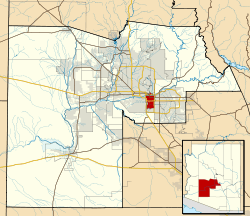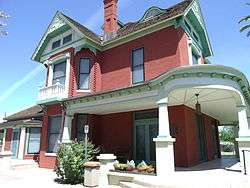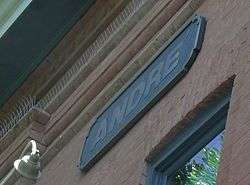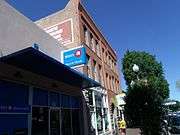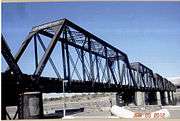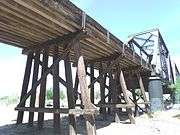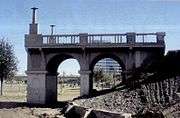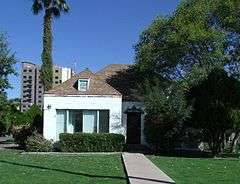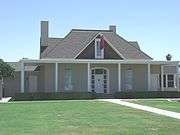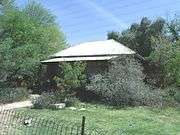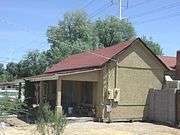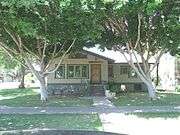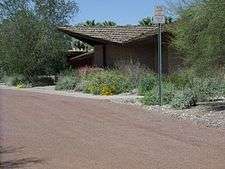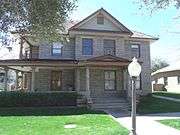| Charles T. Hayden House was built in 1871 and is located at 2000 1 W. Rio Salado Parkway. It is the oldest building in Tempe. It was the residence of Charles Trumbull Hayden and his family. The Hayden family moved out of the house in 1889. It was listed in the National Register of Historic Places on October 10, 1984 reference #84000173. |
| The Gonzales-Martinez House was built in 1880 and is located at 320 W. First St. in Tempe, Az. Ramon Gonzales was a freighter in Southern Arizona until he relocated to Tempe in about 1877 and was employed by Charles T. Hayden. Jesus Martinez acquired the property in 1892. List in the National Register of Historic Places on May 7, 1984 reference #84000708. |
| The Farmer-Goodwin House was built in 1883 and is located at 820 S. Farmer Ave. in Tempe, Az.. The house is one of the best-preserved and unique adobe structures in the state. Hiram Bradford Farmer purchased the house for $3,000 in January of 1886. Farmer was the first professor and principal at the Territorial Normal School (now Arizona State University) when it opened in February of 1886. List in the National Register of Historic Place on December 26, 1972 reference #72000197. |
| The Brown-Strong House was built in 1883 is located at 604 S. Ash Ave (now 605). Samuel Brown was a blacksmith who served as Tempe’s mayor from 1902 to 1903. He served as Town Marshal, tax collector and supervisor of streets until 1912. The property is listed in the Tempe Historic Property Register. |
| Roy Hackett House was built in 1888 and is located at 401-405 W. 4th St. This building is the oldest fired brick building in Tempe, and perhaps possesses the most original integrity of location, design, setting, materials, workmanship, feeling and association of any territorial commercial building in Maricopa County. It was listed in the National Register of Historic Places in 1974, reference #74000458. |
| The Sampson-Tupper House was built in 1888 and is located at 601 W. 3rd St. The house was built for Mrs. Lulu Sampson, a widow and teacher in the Tempe School system. The house was originally built and located at 109 W. Sixth St. and moved to its current location in order to be preserved. The property is listed in the Tempe Historic Property Register. The house is located in the Roosevelt Addition Historic District which is listed in the National Register of Historic Places reference number 09000959. |
| The Gage House was built in 1888 and is located at 115 W. University Dr. George Gage was a significant Tempe developer during the 1888 to 1909 period. He was responsible for much of the early urban development of Tempe. The property is listed in the Tempe Historic Property Register. |
| The Dines-Hight House was built in 1889 and is located at 508 W. Fifth St. in Tempe, Az. The Dines-Hight House is significant as for its association with Tempe’s original townsite. Listed in the Tempe Historic Property Register. |
| The Elias-Rodriguez House was built in 1890 and is located at 927 E. Eighth St. in Tempe, Az. It is one of the oldest remaining adobe houses in Tempe. The building houses a museum of local Mexican-American history. The property is listed in the Tempe Historic Property Register. The property was listed on the National Register of Historic Places on May, 7, 1984, reference number 84000684. |
| The Gov. Benjamin B. Moeur House was in built 1892 and is located at 34 E. 7th Street. The house was owned by Dr. Benjamin B. Moeur who in 1896 was the town's only full-time physician. He served two terms as governor of Arizona, while still living in this house. It was listed in the National Register of Historic Places on May 30, 2012. reference #12000295. |
| The Niels Petersen House was built in 1892 and is located at 1414 W. Southern Ave. in Tempe, Az. The house was built in 1892 by Niels Petersen, a Danish immigrant who came to Tempe in 1871. He developed a ranch with substantial land holdings, was president of the Farmers and Merchants Bank, co-founder of the Methodist Episcopal Church, and a representative at the 18th Territorial Legislature. Creighton, the architect, worked for many years in Arizona, and among his extant works are the Pinal County Courthouse, Old Main at the University of Arizona, and the Tempe Hardware Building on Mill Avenue in Tempe. It was listed in the National Register of Historic Places on January 5, 1978 reference #78000553. |
| The Spear House was built in 1893 and is located at 1015 S. Farmer Ave. in Tempe, Az. Myron Spear (a Civil War veteran) and his wife Sylvia Spear built the house in 1893. Myron worked as a baker and a drayman, and for a time had his own express business; Sylvia worked as a nurse. It is listed in the Tempe Historic Property Register. |
| Harry Walker House (as it looks today) was built in 1903 and is located at 118 E. 7th Street. The architectural style: Neo-Colonial Influence. It was listed in the National Register of Historic Places on May 7, 1984 reference #84000745. |
| The Harrington-Birchett House was built in 1895 and is located at 202 E. 7th Street. The house was built by J.W. Harrington and sold in 1904 to Mattie Birchett. Matties' son, Joseph T. Birchett married Guess Eleanor Anderson that same year. He served as Tempe's mayor from 1912-1914. Guess was the sister of Honor Anderson Moeur, wife of Arizona Governor Benjamin B. Moeur. It was listed in the National Register of Historic Places on May 7, 1984 reference #84000716. |
| The C.P. Mullen House , a.k.a. D. R. Van Petten House , was built in 1900 and is located in 918 Mill Ave. It was listed in the National Register of Historic Places in May 7, 1984, reference #84000734. |
| The Morrow-Hudson House was built in 1904 and is located at 1203 E. Alameda Dr. in Tempe, Az. This house belonged to Estmer Hudson was an Arizona pioneer who in 1916, with Charles Henry Waterhouse introduced the new Egyptian cotton, commonly known as Pima cotton. Listed in the National Register of Historic Places on May 7, 1984 reference #84000733. |
| The Hugh Laird House was built in 1908 and is located at 821 S. Farmer Ave. in Tempe, Az. The house belonged to Hugh Laird a businessman and public servant. Laird career was a registered pharmacist and owner of Laird and Dines Drug Store. He served 12 years as Tempe postmaster and two terms as a representative in the state legislature. He also served a 32-year consecutive seat on the Tempe City Council, 14 of those years as Mayor. Listed in the National Register of Historic Places on May 7, 1984 reference #84000726. |
| The Cummins House was built in 1909 and is located at 839 S. Farmer Ave. in Tempe, Az. Aaron and Margaret Cummins acquired undeveloped Lot 10, Block 1 of Farmer’s Addition in May 1908, mortgaged the property in March 1909, and built the house soon thereafter. Listed in the Tempe Historic Property Register. |
| The Chavez House was built in 1910 and is located at 927 S. Farmer Ave. in Tempe, Az. Ramon immigrated to the U.S. from Mexico in 1904 and married Nicolasa in 1910; he worked in the Tempe area as a ranch laborer. Ramon and Nicolasa Chavez built the house and remained at the address until 1930.Listed in the Tempe Historic Property Register. |
| The W.A. Moeur House was built in 1910 and is located at 850 S. Ash Ave. W.A. Moeur was the brother of Gov. Benjamin B. Moeur. He assisted in organizing the Tempe School system and was a member of the first Tempe school board. The house is used as a restaurant. The property is listed in the Tempe Historic Property Register. The property was listed on the National Register of Historic Places on May, 7, 1984, reference number 84000730. |
| The Carns- Buck House was built in 1914 and is located at 902 Farmer Ave. This was one of the first houses built in the Goodwin Addition. The property is listed in the Tempe Historic Property Register. |
| The D.J. Frankenberg House was built in 1915 and is located at 2222 S. Price Road in Tempe, Az. This house was built by Don Juan Frankenberg. Frankenberg and his family were pioneers and ranchers in the Tempe area as early as 1888. In 1915, D. J. Frankenberg built this house for his family on the family homestead. That same year, he was selected to experiment with Pima Long Staple Cotton as part of the program with the Government Experimental Farm (USDA) at Sacaton, Arizona. Cotton farming was successful in the Tempe area until the loss of the market in the 1920s. Listed in the National Register of Historic Places on January 2, 2008 reference #07001333. |
| The Judd House was built in 1915 and is located at 1208 S. Farmer Ave. in Tempe, Az. This house was built by Alfred and Ellen Bell who acquired a twenty-five-acre farm in the southwest quarter of the northwest quarter of Section 21 (T1N R4E) in 1914. In 1938, Orion and Anna Judd became the owners of the house. |
| The Byron Redden House was built in 1918 and is located at 948 S. Ash Ave. in Tempe, Az. The house was built in 1918 by Charles H. Gable, and was bought by Byron Redden in 1920. Byron Redden was a successful rancher and served 25 years as a zanjero (irrigation canal manager) for the Tempe Canal Company. Listed in the National Register of Historic Places on May 7, 1984 reference #84000738. |
| The Windes- Bell House was built in 1920 and is located at 24 9th Street. The house is significant for its association with Tempe attorney Dudley Windes and with Tempe pioneer Ellen Bell. The property is listed in the Tempe Historic Property Register. |
| The Nichols House was built in 1920 and is located at 919 Maple Ave. The property is listed in the Tempe Historic Property Register. |
| The Lowell Redden House was built in 1920 and is located at 333 E. Carver St.. The property was listed in the National Register of Historic Places on February 13, 1985, reference Number 85000407. |
| The B.H. Scudder Rental House was built in 1920 and is located at 919 S. Maple Ave. The property was listed in the National Register of Historic Places on May 7, 1984, reference number 84000740. |
| The Scudder House was built in 1929 and is located at 959 S Ash Avenue. The house belonged to Benjamin Scudder, a local educator who built several rental houses in the Maple and Ash Avenue area. The property is listed in the Tempe Historic Property Register. |
| The Sidney B. Moeur House was built in 1921 and is located at 903 S. Ash Ave. Sidney B. Moeur was the son of W.A. Moeur and nephew of Arizona Governor Benjamin B. Moeur. The property is listed in the Tempe Historic Property Register. |
| The Selleh House was built in 1925 and is located at 1104 S. Mill Ave. During the Great Depression Joseph “Joe” Selleh played baseball, golf and tennis for ASU. He also coached the baseball, golf and tennis teams. Selleh served as an assistant with the football team. The house was listed in the National Register of Historic Places in November 5, 2005, reference #05001197. |
| The Minson House was built in 1925 and is located at 1034 S. Mill Ave. The property is listed in the Tempe Historic Property Register. |
| The Elliot House was built in 1925 and is located in 1010 Maple Ave. It was listed in the National Register of Historic Places in May 7, 1984, reference #84000693. |
| The Guthrie House was built in 1927 and is located at 600 5th Street. The property is listed in the Tempe Historic Property Register. |
| The Blakely House was built in 1927 and is located at 305 S. Roosevelt Street.The property is listed in the Tempe Historic Property Register. |
| The McGinnes House was built in 1928 and is located at 915 Maple, Ave. The property is listed in the Tempe Historic Property Register. |
| The Hiatt House is also known as the Barnes House . It was built in 1928 and is located at 1104 Ash Ave. It was listed in the National Register of Historic Places in May 7, 1984, reference #84000720. |
| The Harris House was built in 1931 and is located 823 Maple Ave. The property is listed in the Tempe Historic Property Register. |
| The Lucier/O’Neill House was built in 1933 and is located at 1114 Maple Ave. The property is listed in the Tempe Historic Property Register. |
| The Butler (Gray) House was built in 1934 and is located at 1220 Mill Ave. The property is listed in the Tempe Historic Property Register. |
| The Bauer House was built in 1934 and is located at 599 5th Street. The property is listed in the Tempe Historic Property Register. |
| The Douglas-Gitlis House was built in 1935 and is located at 1206 Ash Ave. The property is listed in the Tempe Historic Property Register. |
| The Marriot House was built in 1935 and is located at 606 S. Roosevelt Street. The property is listed in the Tempe Historic Property Register. |
| The Baker House was built in 1936 and is located at 1029 Maple Ave. The property is listed in the Tempe Historic Property Register. |
| The Governor John Howard Pyle House was built in 1938 and is located at 1120 S. Ash Avenue. Pyle was the 9th Governor of Arizona (Arizona Governor, 1950-1954). The property is listed in the Tempe Historic Property Register. |
| The Diefenderfer House was built in 1939 and is located at 1223 S Farmer Avenue. This one-story masonry house was built with Bungalow influences by Federick and Mary Diefenderfer, a retired couple who acquired the lot in 1939. The property is listed in the Tempe Historic Property Register. |
| The Wexler House was built in 1940 and is located at 1215 Maple Ave. The property is listed in the Tempe Historic Property Register. |
| The Barnes House was built in 1940 and is located at 1203 Ash Ave. The property is listed in the Tempe Historic Property Register. |
| The Burket House was built in 1945 and is located at 501 5th Street. The property is listed in the Tempe Historic Property Register. |
|
